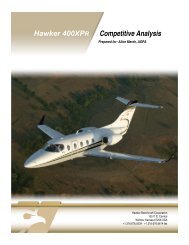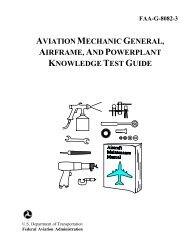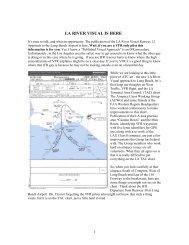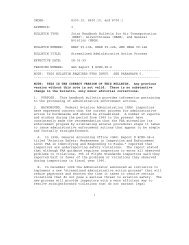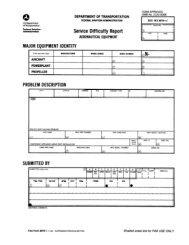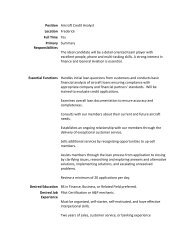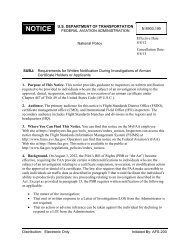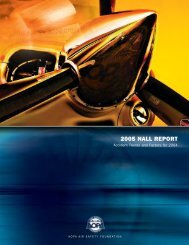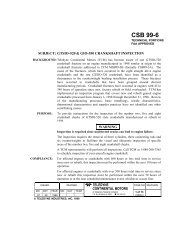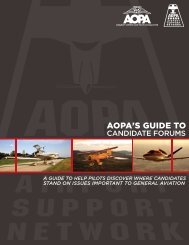2008 Nall Report - Aircraft Owners and Pilots Association
2008 Nall Report - Aircraft Owners and Pilots Association
2008 Nall Report - Aircraft Owners and Pilots Association
You also want an ePaper? Increase the reach of your titles
YUMPU automatically turns print PDFs into web optimized ePapers that Google loves.
ACCIDENT FACTORS: HIGH-RISK PHASES OF FLIGHT<br />
Characteristics of Descent/Approach<br />
Accidents<br />
Fixed-gear single-engine aircraft accounted for a<br />
smaller proportion of descent/approach mishaps<br />
than of other types of accidents (Figure 34).<br />
<strong>Aircraft</strong> Involved in Descent/Approach<br />
Accidents<br />
All Accidents Fatal Accidents<br />
Single-engine fixed 38 (62.3%) 10 (45.5%)<br />
SE retractable 16 (26.2%) 8 (36.4%)<br />
Multiengine 7 (11.5%) 4 (18.2%)<br />
Figure 34<br />
The great majority of descent/approach accidents<br />
occurred on personal flights (78.7 percent), as<br />
did 18 of 22 fatal accidents. Eight of 11 accidents<br />
in IMC were fatal (73 percent) compared to 28<br />
percent in VMC (Figure 35). Eight of 13 that occurred<br />
at night (62 percent) were fatal compared<br />
to 29 percent of daylight accidents. The eight fatal<br />
accidents in IMC were equally split between day<br />
<strong>and</strong> night, <strong>and</strong> seven of them involved attempted<br />
approaches into airports where weather was definitely<br />
(3) or possibly (4) below minimums.<br />
Flight Conditions During Descent/Approach<br />
Accidents<br />
All Accidents Fatal Accidents<br />
Day VMC 42 (68.9%) 10 (45.5%)<br />
Day IMC 6 (9.8%) 4 (18.2%)<br />
Night VMC 8 (13.1%) 4 (18.2%)<br />
Night IMC 5 (8.2%) 4 (18.2%)<br />
Figure 35<br />
Accident Case Study<br />
NYC07FA056<br />
Beech BE36, Wayne, New Jersey<br />
One fatality<br />
History of Flight<br />
The airplane approached the destination airport in night<br />
instrument meteorological conditions. The pilot received a<br />
clearance for the localizer approach, <strong>and</strong> radar <strong>and</strong> global<br />
positioning system (GPS) data revealed the airplane was<br />
established on the localizer course centerline. The airplane<br />
crossed the final approach fix 200 feet below the minimum<br />
altitude for the fix, <strong>and</strong> over the next 1.5 miles, descended<br />
on an approximate 7-degree approach angle <strong>and</strong> a 945<br />
feet-per-minute rate of descent. The airplane continued its<br />
descent <strong>and</strong> struck trees on a ridgeline approximately 400<br />
feet below the intermediate altitude for that segment of the<br />
approach. Examination of the wreckage revealed no mechanical<br />
anomalies.<br />
Pilot Information<br />
The pilot, age 55, held an airline transport pilot’s certificate<br />
for multiengine airplanes restricted to centerline thrust <strong>and</strong><br />
a commercial certificate with instrument rating for helicopter<br />
<strong>and</strong> single-engine airplane. He was a certificated flight<br />
<strong>and</strong> instrument instructor for single- <strong>and</strong> multiengine airplanes<br />
<strong>and</strong> helicopters with 4,455 hours total flight time <strong>and</strong><br />
2,000 hours in the accident make <strong>and</strong> model.<br />
Weather<br />
Sky conditions were 500 scattered with visibility 4 statute<br />
miles in mist; temperature <strong>and</strong> dew point were both 7 degrees<br />
C. Witnesses reported visibility as low as 1/8 statute<br />
mile at the accident site. Winds were light <strong>and</strong> variable at 3<br />
knots.<br />
Probable Cause<br />
The pilot’s failure to comply with the published instrument<br />
approach procedure, which resulted in controlled flight into<br />
terrain.<br />
ASF Comments<br />
This pilot may have been trying to “duck under” the clouds<br />
in order to get visual contact with the runway. It is critical<br />
to comply with minimum altitudes on instrument approaches.<br />
A normal ILS is 3 degrees <strong>and</strong> this aircraft was descending<br />
at double that. An unstabilized approach after the final<br />
approach fix/waypoint should always result in a go-around.<br />
23



